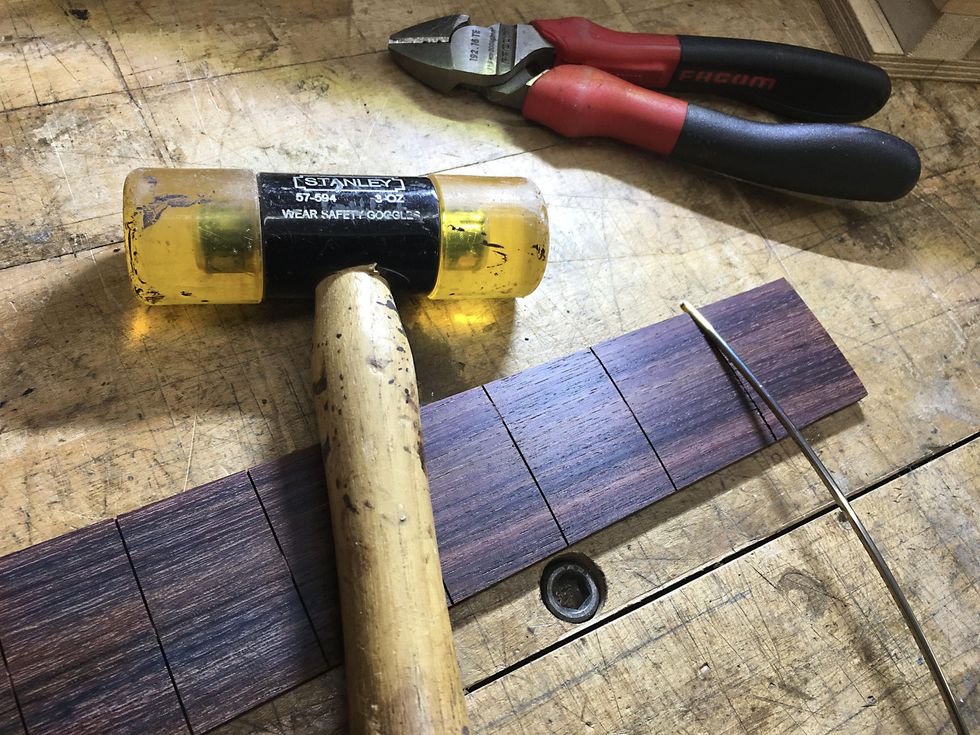
It’s fun to binge-watch YouTube videos, and for guitarists there are a plethora of them to behold. There are mashups of metal and funk, as well as never-before-seen footage of classic acts in every genre. Then, there are the how-to videos that have helped me and countless others learn new fretboard moves. My favorites are the ones that decode songs, unlocking finger positions and chord voicings that have eluded me for years. But next to that, I enjoy watching guitar-making videos. As a builder whose 50-year career has allowed me to tour and work in dozens of guitar factories and shops, you might wonder why on earth I would subject myself to this. The answer is that you can always learn something new if you know what to watch for. New and correct information is certainly what most of us are hoping for when we spool up a video.
The first thing I look for is if a shop is organized and relatively clean. I say relatively, because woodworking is, by nature, somewhat messy. All that cutting and sanding creates shavings and dust that’s hard to control completely. Most decent shops have some sort of dust collection, so when you spy ankle-deep wood shavings, you might wonder where the priorities are. Wood dust is flammable at best and explosive at worst, so if you buy a guitar from a shop that’s a ticking time-bomb, you may not be able to count on any long-term customer service. I’ve written before about the benefits of being well-ordered, and I think that it speaks volumes about the builder’s attitude. Clutter slows things down as little interruptions in the workflow add up to mistakes or even bankruptcy. I’m not saying that great work can’t be done in a messy shop, but I’m not a gambling man either.
“Wood dust is flammable at best and explosive at worst, so if you buy a guitar from a shop that’s a ticking time-bomb, you may not be able to count on any long-term customer service.”
For a guy who hates hammers, I’ve got a lot of them. Sometimes it’s the only tool that will get the job done. One task that a hammer isn’t good at is fretting. Sure, that’s the way it used to be done back in the good old days—you know, when all those unplayable budget guitars were being sold at department stores. I cringe when I see builders smacking a neck with a hammer, and you should too. In a repair shop, there’s room for the hammer as an adjustment tool, but it takes hundreds of hours to get really good at it.
The problem is that hammers aren’t very consistent, and seating frets properly demands uniformity. Hit the fret a little too hard and it’s buried, not hard enough and you get a high fret. That’s why the best shops use a mechanical press of some sort.
This brings me to another chilling moment in guitar videos: the fret leveling. Fretwire manufacturing is a precise art with tight tolerances well within the range of good playability. That means if the fretboard is true and all the frets are seated properly, no fret leveling is needed at all. So, when a video is about doing a “fret job” on a brand-new build, you know that something was botched in an earlier step. Fret filing is reserved for compensating for uneven fret wear or impact damage. Of course, if the fretboard radius is sloppy, there’s no way the frets will be level regardless of how you put them in. I roll my eyes when I see a hand router on a plywood fixture used to crown a fretboard. It’s certainly faster than sanding with a radius block or swing fixture, but not nearly as accurate. To be clear, if a router is followed with a more precise shaping process, it’s perfectly acceptable. But you can see that if the first step isn’t right, it’s just kicking the can down the road as everything after that compounds the issue.
Finishing is another area that separates the good from the bad and ugly. A good spray painter is amazing to watch, as they systematically layer smooth and consistent passes over an instrument. You don’t want to see the painter waving the gun around from side to side with a lot of wrist movement like they’re watering a garden. The trick is keeping the speed and distance consistent. When done correctly, clear coats lay out flat and shiny and barely need to be buffed. It takes a long time to learn, but when you get it right, it’s like magic.
There are a lot of great ideas and unconventional yet effective methods to be seen in how-to videos. I’m always happy when I see something brilliant and noteworthy, but occasionally it’s the opposite. Just like the “lessons” that don’t quite get the chords right or ignore the fact that a song was recorded in an open tuning, home-guitar-building videos are not always insight into best practices. That’s doesn’t mean that they can’t be entertaining. So, get out the popcorn and settle in for some luthier jump scares.

0 Comments :
Post a Comment